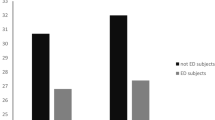Background: The purpose of this study was to evaluate the impairment of body image in patients with binge eating disorder (BED). Materials and Methods: A 3-year longitudinal study was undertaken in 25 BED obese patients and 26 non-BED obese patients who had undergone biliopancreatic diversion (BPD) for obesity. The body image was evaluated by the Eating Disorder Inventory body dissatisfaction scale. Results: Within the third postoperative year, 95% of patients had stopped binge eating. After the first postoperative year, the BED patients showed body dissatisfaction scores higher than those of the non-BED group, whereas the longer-term results were closely similar. Conclusions: Over the long term following BPD, binge eating disappears, which suggests that the loss of control over food intake is mainly dependent on dieting and on the preoccupation with food and body shape. The derangement of body image in obese patients with BED is only partly dependent on inner feelings. In fact, the stable weight normalization after BPD is accompanied by a sharp improvement in body image in all cases. It appears that the complete normalization requires more time in BED patients than in their non-BED counterparts.
Similar content being viewed by others
Author information
Authors and Affiliations
Rights and permissions
About this article
Cite this article
Franco Adami, G., Marinari, G.M., Bressani, A. et al. Body Image in Binge Eating Disorder. OBES SURG 8, 517–519 (1998). https://doi.org/10.1381/096089298765554070
Published:
Issue Date:
DOI: https://doi.org/10.1381/096089298765554070




